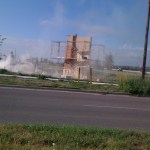OSHA
A marriage of public health science and civil rights is one way to describe the lifework of John Froines, PhD, professor emeritus at UCLA School of Public Health. After a 50-year career in academia and public service, and the untolled contributions from it, Froines was recognized this week by the internationally renowned Collegium Ramazzini.
The nomination letter submitted to the Collegium by his colleagues captures many highlights of Froines’ impact over several decades, such as:
His high-profile role in the 1960’s anti-war and civil rights movements
His position with the Vermont State…
Earlier this month I wrote about the merits of policies that require conflict of interest disclosures. Last week, two items also about conflicts of interest landed in my in-box. They were just too juicy to not take a bite, and write about here.
First came a commentary from the October 2013 issue of the Annals of Occupational Hygiene written by the journal’s chief editor Noah Seixas, PhD, MS. The lead paragraph reads:
"On 6 June 2013, a court in New York handed down a decision that calls into question the validity of research that was sponsored by Georgia-Pacific [GP] and published…
"Es ridículo,” was the reaction of a poultry plant worker when he heard of the USDA's proposal to "modernize" poultry slaughter. The agency's January 2012 proposal (77 Fed Reg 4408) would allow companies to increase assembly line speeds from about 90 to 175 birds per minute, and remove most USDA inspectors from the poultry processing line.
The Obama Administration should have heard the loud and clear opposition from civil rights, food safety, public health and the workers’ safety communities to the USDA’s proposal. When the public comment period closed in May 2012, the Southern Poverty…
Who paid for the study? That's an important piece of information to have when considering a study's methods and reported findings. Financial ties are the most obvious conflicts of interest, but others include pre-publication review and other requirements imposed by a study’s sponsors.
Scientists publishing papers in the leading biomedical journals have, for at least ten years, been providing readers with disclosures of real or potential conflicts. The editors of more than 1,300 medical journals require authors to comply with specific disclosure policies. Researchers from…
While OSHA has never been the most robustly funded federal agency, its efforts and regulatory authority have helped prevent countless deaths, injuries and illnesses on the job. However, recent budget cuts and future budget cut proposals threaten those gains, and it's no stretch to say that worker health and safety hang in the balance.
In a report released in late August by the Center for Effective Government (formerly OMB Watch), author Nick Schwellenbach chronicled what austerity means for OSHA and the workers it protects. To first put the issue and impacts of slashed budgets in broader…
It's Day #2 of the Tea Party's shutdown of the federal government. Shuttered entrances to national parks and museums are immediate and visible signs of this idiocy. The shutdown's effect on key federal public health programs are probably less obvious, but could have substantially more adverse impact on the U.S. population. Superbug's Maryn McKenna wrote yesterday on just a few ways that interruptions at the Centers for Disease Control and Prevention, the Food and Drug Administration and USDA, could affect your's (and the world's) health. With just a few examples…
Earlier this month, the long-awaited, three-year delayed OSHA silica proposal was published. It's a proposed regulation designed to protect workers employed in construction, foundries, glassmaking, road building and other industries from silicosis, lung cancer and other silica-related diseases.
The proposal does not cover, however, some of the most heavily exposed workers in the U.S.: those employed in the mining industry. These are the workers who routinely drill, cut and load tons of quartz, some of whom work day after day in clouds of silica-laden dust. Protections for…
Senator Kirsten Gillibrand introduced last week the Safe Meat and Poultry Act (S. 1502). The bill would require USDA's Food Safety Inspection Service (FSIS) to take new steps to decrease foodborne pathogens, including authority to compel producers to recall contaminated meat and poultry.
The legislative text is 73 pages long, but one short paragraph caught my eye: a provision addressing the serious health and safety hazards to which meat and poultry workers are exposed. It's an issue that we've written about many times (e.g.. here, here, here, here, here, here, here, here,…
Occupational health hazards are often hidden, and may not even be appropriately disclosed to workers who are exposed. They are usually shielded from public view, meaning they don't get the attention needed to ensure protections are put in place to address them. But every once in a while, hazards to workers' health are right in front of you.
Yesterday morning, I was driving on FM 1626 in Kyle, TX and passed this scene: Two construction workers standing in a nasty cloud of dust. The men were working at the new campus of Austin Community College in Hays County, TX and…
This week, Liz and I have been highlighting parts of our second annual review of U.S. occupational health and safety. The first two sections of the report summarize key studies in the peer-reviewed literature, and an assessment of activities at the federal level. In section three of the report we present high points---and a few low points---from state and local governments on workers’ rights and safety protections. These include:
New laws in Portland, Oregon and New York City requiring many employers to offer paid sick leave to their employees. With 22…
As Liz Borkowski noted yesterday, we are following up on a tradition that we started last year to mark Labor Day. We released our second annual review of U.S. occupational health and safety for Labor Day 2013.
Liz explained in her post our objectives in preparing the report. She also highlighted its first section which profiles some of the best research from the year published in both peer-reviewed journals and by non-profit organizations. Here’s a peek at section two of the report on activities at the federal level:
Sequestration and other budget cuts have affected our…
For older workers, the most dangerous occupational move may be getting behind the wheel.
Last Friday, the Centers for Disease Control and Prevention released data showing that among highway transportation incidents, which are the leading cause of occupational death in the country, the highest fatality rates occur among workers ages 65 years old and older. In fact, workers in that age group experienced a fatality rate three times higher than workers ages 18 to 54. The unfortunate trend was seen across industries and occupations and among most demographic groups, according to data published in…
President Obama's regulatory czar, Howard Shelanski, has been on the job for a month. During his confirmation hearing Shelanski expressed his commitment to transparency. He suggested it was one of his key priorities within the White House's Office of Information and Regulatory Affairs (OIRA) which is housed within the Office of Management and Budget (OMB). As noted, however, by CPR scholar Sidney Shapiro and his colleague James Goodwin, OIRA has a long history of secrecy with respect to its role in the centralized review of agencies' regulatory activities. Many in the…
After more than 900 days of "review" by the White House's Office of Information and Regulatory Affairs (OIRA), OSHA announced it was publishing a proposed rule to protect workers who are exposed to respirable crystalline silica. It's a workplace hazard that causes the irreversible and progressive lung disease silicosis, and is also associated with lung cancer, autoimmune disorders and kidney disease. About 2.2 million workers are exposed to the fine dust in their jobs, many of which are employed in the construction industry. I've been writing here for about two years on the…
Marshall Turner, 55 and James "Bubba" Rains, 34 were part of an asphalt paving crew, working on I-55 in Crittenden County, Arkansas. On the evening of April 16, 2013, a pick-up truck driven by an Illinois man swerved into the closed-off construction work zone and struck Turner and Rains. Both men were fatally injured.
The Bureau of Labor Statistics reports that, on average, 110 workers are killed each year while working in roadway and highway work zones. In 2011, the most recent year in which data is available, the number of fatalities was 119. Thirteen of the deaths…
In their efforts to protect the most vulnerable workers from illegal workplace practices and conditions, worker centers have now attracted the million-dollar ire of formidable anti-union forces. And while advocates say it's a sign of worker centers' success, it's still a worrisome trend that's made it all the way to the halls of Congress.
In late July, a full-page ad ran in the Wall Street Journal accusing worker centers of being fronts for labor unions. The ad was paid for by a group calling itself the Center for Union Facts, a nonprofit with a $3 million-plus budget run by industry lobbyist…
Federal OSHA announced this week a settlement agreement with Wal-Mart for serious safety violations found at its store on Chili Avenue in Rochester, NY. Lots of companies sign settlement agreements with OSHA, but few of them involve making safety corrections at multiple worksites controlled by the same firm. This settlement agreement will apply to 2,857 of Wal-Mart's 4,600 retail establishments in the U.S. The 2,857 stores are all of the stores located in States where federal OSHA has enforcement jurisdiction.
How will OSHA monitor Wal-Mart's compliance with the settlement…
Finally! After far too much hullabaloo about the cost of regulations, there was a U.S. Senate hearing today on why public health regulations are important, and how delays by Congress and the Administration have serious negative consequences for people's lives. Senator Richard Blumenthal (D-CT) called the hearing entitled "Justice Delayed: The Human Cost of Regulatory Paralysis," the first one conducted by the Senate Judiciary Committee's newly created Subcommittee on Oversight, Federal Rights and Agency Action. The witnesses included a parent-turned advocate for automobile…
Pilgrim's Pride can't seem to get its act together safely handling highly toxic and explosive gases. The firm---the second largest poultry producer in the world with annual net sales of $8.1 Billion---received citations again from federal OSHA concerning its failed safety management of anhydrous ammonia.
OSHA announced this month $170,000 in proposed penalties for 9 serious, 1 willful and 1 repeat violation at the company's De Queen, Arkansas plant. All of the alleged violations involve requirements under OSHA's process safety management standard for control of highly hazardous…
Celeste wrote earlier this month about a public meeting at which the US Chemical Safety Board would vote on whether to label several of their outstanding recommendations to OSHA as having seen unacceptable progress. I attended the day-long meeting, and thought the CSB staff and board members made a strong case for the “unacceptable” designations, which the board unanimously voted to adopt. Throughout the meeting, the CSB was careful to acknowledge the progress OSHA had made in addressing the hazards, the factors that impede effective OSHA action, and the preventability of explosions and other…

